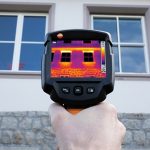Across the country, Australia’s climate varies in both temperature and humidity. From steamy far North Queensland that rarely drops below 25 degrees to temperate Hobart where the mercury rarely goes above this range, mould and humidity are a common concern for business and home owners.
Mould and humidity go hand in hand, lurking in areas of construction defects and high moisture. As a result of this combination, structural bearings can be affected and so can the health of employees and building residents.
Fortunately, both during and after construction, thermal imaging cameras can be used to measure humidity levels and identify mould before it becomes a major issue.
In addition, a quick discovery can mean that preventive measures can be applied to ensure building integrity and the health of those in the vicinity.
How does a thermal imager assist?
As well as accurately detecting surface temperatures, thermal imagers are capable of measuring humidity levels. Testo currently have a patent-pending case on its “humidity image” that can display the level for “each individual measuring value in the image”.
The thermal imager relies on its temperature measurement capabilities to provide an accurate reading on humidity levels.
The risk of mould is displayed through the traffic light principle so areas in green pose no risk to building structures or health. However, an amber image suggests further investigations are needed as mould formation is possible in that area. A red reading is a warning that there is a high mould risk that requires urgent attention.
Humidity readings
With Testo thermal cameras it is easy to transfer the images to appropriate software where it can be collated and presented to relevant parties. This is a helpful application as accurate records of mould problems can be stored away and then referred against newer readings in time.
The easy-to-read figures and images can highlight the mould risk and prompt home and business owners into action to solve the issue before it gets worse.
What features does a thermal imager need?
To be able to detect and identify potential mould problems, your thermal imager will have to meet certain specifications. It requires a resolution of 160 x 120 pixels and a minimum sensitivity of less than 80 Millikelvin (mK).
A device perfect for this application is the testo 875-2i Versatile Thermal Imager. If you have any further questions about how thermal imagers can detect humidity and mould, get in contact with Testo today.









 Reduce cooking oil costs while ensuring quality
Reduce cooking oil costs while ensuring quality Expert knowledge on CO2 monitoring
Expert knowledge on CO2 monitoring Refrigeration knowledge - in 3 modules
Refrigeration knowledge - in 3 modules



